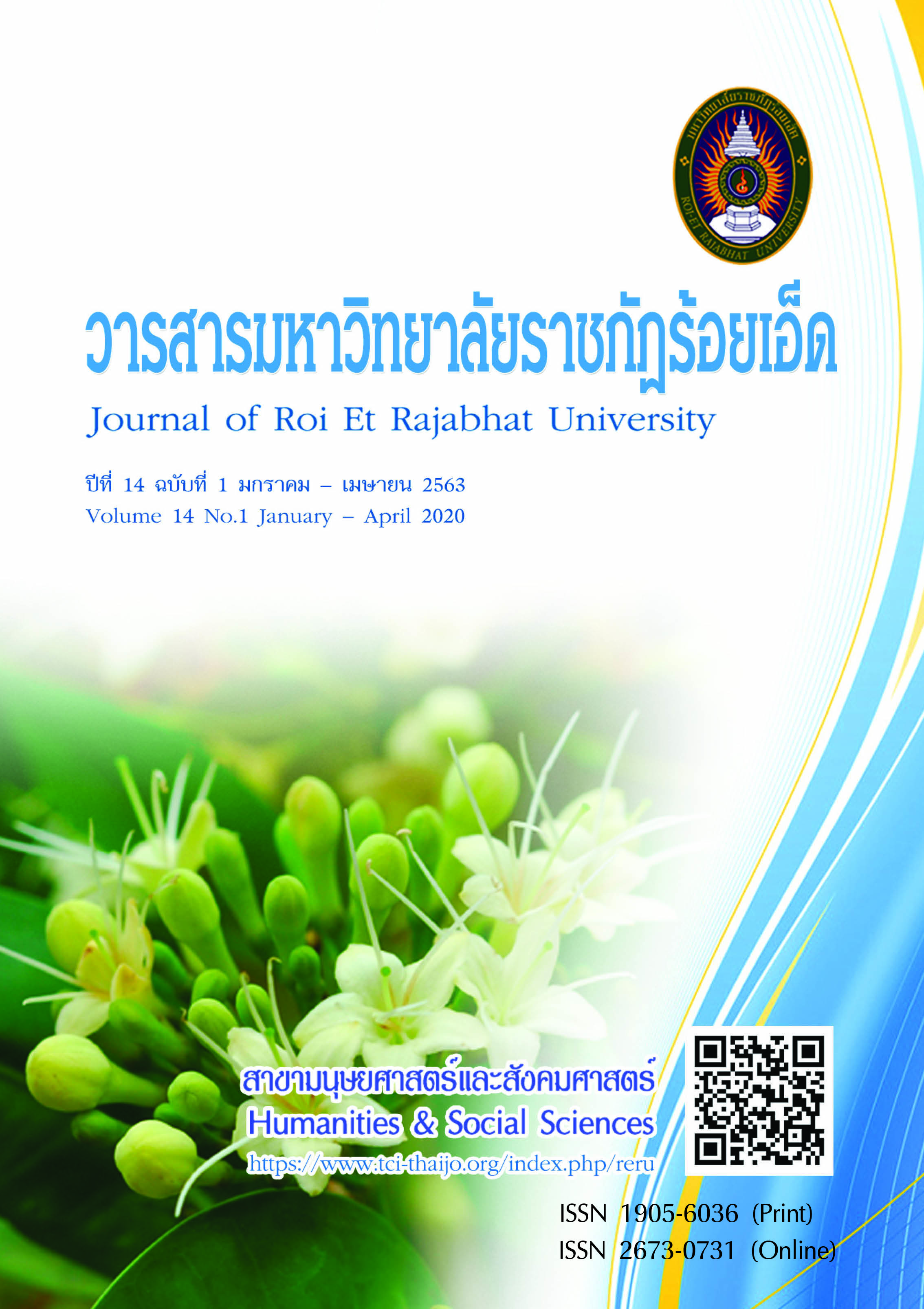The knowledge synthesis of English Teaching Based on Content and Language Integrated Learning Approach (CLIL)
Keywords:
approach, English, Content and Language IntegrationAbstract
The purposes of this article are to synthesize the knowledge and to present the idea based on Content and Language Integrated Learning Approach or CLIL with the teachers of English and those who teach contents in courses using English as the medium to learn the language naturally such as Sciences, Mathematics, Health education, Geography and Arts. Furthermore, this article also present the components of 4Cs of CLIL including Content, Cognition, Communication and Culture, the proportion of learning management (Hard CLIL or Soft CLIL), the benefits of CLIL, teachers and students’ roles, evaluation and assessment. In addition, this article has presented the examples of Content and Language Integrated Learning Approach used in many countries that we can apply for English teaching and learning in the future.
References
ปราณภา โหมดหิรัญ. (2559). ผลของโปรแกรมอบรมครูเพื่อสอนภาษาอังกฤษด้วยเนื้อหาอาเซียนและแนวคิด CLIL ที่มีต่อเนื้อหาความรู้ ทัศนคติและการนำความรู้ไปใช้ในกิจกรรมการสอนภาษาอังกฤษของครูภาษาอังกฤษ มัธยมศึกษา สังกัดองค์กรปกครองส่วนท้องถิ่นแห่งประเทศไทย. วารสารครุศาสตร์ จุฬาลงกรณ์มหาวิทยาลัย, 44(3), 114-130.
สถาบันภาษาอังกฤษ. (2557). คู่มือการจัดการเรียนการสอนภาษาอังกฤษแนวใหม่ตามกรอบมาตรฐานความสามารถทางภาษาอังกฤษ
ระดับมัธยมศึกษา. กรุงเทพฯ: โรงพิมพ์องค์การสงเคราะห์ทหารผ่านศึก.
อาทิตย์ ศรีจันทร์ดร. (2560). ผลของการสอนตามแนวทฤษฎีบรูณาการเนื้อหาและภาษา (CLIL) ที่มีต่อ ความสามารถในการฟัง-พูดและความสนใจในการเรียนภาษาอังกฤษของนักเรียนชั้นมัธยมศึกษาปีที่ 2. วารสารศาสตร์การศึกษาและการพัฒนามนุษย์, 1(2), 174-186.
Bailey, N. (2015). Attaining Content and Language Integrated Learning (CLIL) in the Primary School Classroom.
American Journal of Educational Research, 3(4),418-426.
Ball, P. (2009). Does CLIL work, in D.Hill and P.Alan (eds), The Best of Both Worlds : International Perspectives on CLIL. Norwich Institute or Language Education : Norwich.
Bentley, K and Phillips. (2007). Teaching Sciences in CLIL. unpublish raw data.
Bentley, K. (2009). The TKT Course : CLIL Module. Cambridge: University Press.
Black, P. and William, D. (1998). Assessment and classroom learning. Assessment in Education, 5(1),1-74.
Brown, H.D. (2015). Teaching by Principles : An Interactive Approach to Language Pedagogy. White Plains,
New York : Pearson Education.
Cimermanova, I. (2017). A Dialogue between the Language and Subject Teachers. Retrieved April 5, 2019, from https://www.researchgate.net/publication/322992382_CLIL-
Coyle, D., Hood, P. and Marsh, D. (2010). CLIL: Content: Content and Language Integrated Learning. Cambridge: Cambridge University Press.
Dale, L. and Tanner, R. (2012). CLIL A CLIL Activities : A Resource for Subject and Language Teachers. Cambridge: Cambridge University Press.
Dalton-Puffer, C. (2011). Content and Language Integrated Learning : From Practice to Principle?, Annual Review of Applied Linguistics, 31(8), 182-204
Doiz, A., Lasagabaster, D., and Sierra, J.M. (2014). CLIL and motivation: the effect of individual and contextual variables. The Language Learning Journal, 42(2), 209-224.
Graddol, D. (2006). English Next. London: British Council Publications.
Ikeda. (2013). Does CLIL Work for Japanese Secondary School Students? Potential for the “Weak” of CLIL. International CLIL Research Journal, 2(1), 2013.
Lasagabaster, D. and Linguarum, P. (2015). The impact of type of approach (CLIL versus EFL) and methodology (Book-based versus project work) on motivation. Porta Linguarum 23. 41-57.
Lasagabaster, D, and Sierra, M. J. (2009). Language attitudes in CLIL and Traditional EFL Classes. International CLIL Research Journal, 1(2), 4-17. CLIL–a Dialogue between the Language and Subject Teachers.
Marsh, D. (2002). Content and Language Integrated Learning : The European Dimension /Actions, Trends and Foresight Potential. Retrieved April 5, 2019, from http;//Europa.eu.int/comm/education/languages/index.html
Paraja, K. (2014). Focus on CLIL : a qualitative evaluation of content and language integrated learning (CLIL) in Polish secondary education. Newcastle upon Tyne: Cambride Scholars Publishing.
Pica, T. (2002). Subject-Matter Content : How Does It Assist the International and Linguistic Needs of Classroom Language Learner?. The Modern Language Journal, 86(1), 1-19.
Rea-Dickins, P. (2004). Understanding teachers as agents of assessment. Editorial : Language Testing, 21(3), 249-258.
Ross, S.J. (2005). The Impact of Assessment Method on Foreign Language Proficiency Growth. Applied Linguistics, 26(3), 317-342.
Skeet, J. (2011). Reflections on CLIL. Retrieved April 5, 2019, from http;//clilreflections.blogspot.hk/2011/12/8-cs-of-clil.html
Stevie, D. (2016). Teaching Techniques for CLIL Teacher’s Soul. Retrieved April 7, 2019, from https://www.fluentu.com/blog/educator/clil-teaching/
Downloads
Published
How to Cite
Issue
Section
License
บทความที่ได้รับการตีพิมพ์เป็นลิขสิทธิ์ของวารสารมหาวิทยาลัยราชภัฎร้อยเอ็ด
ข้อความที่ปรากฏในบทความแต่ละเรื่องในวารสารวิชาการเล่มนี้เป็นความคิดเห็นส่วนตัวของผู้เขียนแต่ละท่านไม่เกี่ยวข้องกับมหาวิทยาลัยราชภัฎร้อยเอ็ด และคณาจารย์ท่านอื่นๆในมหาวิทยาลัยฯ แต่อย่างใด ความรับผิดชอบองค์ประกอบทั้งหมดของบทความแต่ละเรื่องเป็นของผู้เขียนแต่ละท่าน หากมีความผิดพลาดใดๆ ผู้เขียนแต่ละท่านจะรับผิดชอบบทความของตนเองแต่ผู้เดียว





